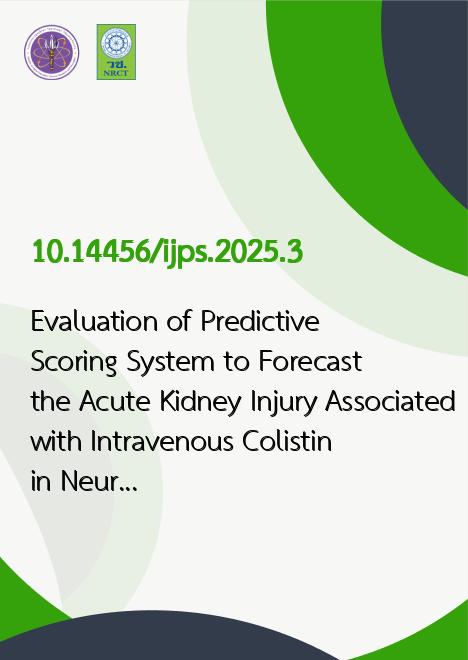
|
Evaluation of Predictive Scoring System to Forecast the Acute Kidney Injury Associated with Intravenous Colistin in Neurosurgical Patients |
|---|---|
| รหัสดีโอไอ | |
| Creator | Sarit Namwong |
| Title | Evaluation of Predictive Scoring System to Forecast the Acute Kidney Injury Associated with Intravenous Colistin in Neurosurgical Patients |
| Publisher | Faculty of Pharmaceutical Sciences KKU MSU UBU |
| Publication Year | 2568 |
| Journal Title | Isan Journal of Pharmaceutical Sciences |
| Journal Vol. | 21 |
| Journal No. | 1 |
| Page no. | 31-50 |
| Keyword | Predictive Scoring System, Forecast, Acute Kidney Injury, Colistin |
| URL Website | https://tci-thaijo.org/index.php/IJPS |
| Website title | Isan Journal of Pharmaceutical Sciences, IJPS |
| ISSN | 19050852 |
| Abstract | Neurosurgical patients who require mechanical ventilation are at high risk of developing Ventilator-Associated Pneumonia (VAP), often caused by Acinetobacter baumannii (A. baumannii), which can significantly increase the risk of mortality. Colistin is commonly used to treat infections in these patients but also increases the risk of kidney dysfunction. Therefore, predicting the likelihood of nephrotoxicity is crucial for reducing the risk of acute kidney injury (AKI) and death. This study aims to evaluate the accuracy of scoring systems in predicting the occurrence of Colistin-induced AKI in neurosurgical patients, as well as to assess the factors contributing to AKI in this patient group. Methods: This study was a cross-sectional, retrospective analysis that collected data from neurosurgical patients who were admitted to the neurosurgery department and received intravenous Colistin between January 1, 2018, and December 31, 2023. Results: A total of 149 neurosurgical cases were included, comprising 64 (43.0%) traumatic head injury patients and 85 (57.0%) hemorrhagic stroke patients. The incidence of A. baumannii (MDR) infection was 92.6%, and the incidence of colistin-induced AKI was 38.9%. Factors associated with Colistin-induced AKI were identified as six factors (p<0.05), including Age 60 years and above (Adjusted OR=2.38, 95% CI 1.01-5.61), a Charlson Comorbidity Index (CCI) score greater than 6 (Adjusted OR=2.81, 95% CI 1.12-7.07), baseline serum creatinine (Adjusted OR=2.83, 95% CI 1.34-5.99), and concurrent use of nephrotoxic drugs such as Aminoglycosides (Adjusted OR=18.17, 95% CI 1.86-176.93), Diuretics (Adjusted OR =3.47, 95% CI 1.02-11.78), and Vancomycin (Adjusted OR=0.10, 95% CI 0.02-0.73). The study on the accuracy of the scoring systems used to predict acute kidney injury found that the Sangthawan's Score had the highest area under the ROC curve (AUC) at 0.78, followed by Yu's Score (AUC=0.62) and Seanglaw's Score (AUC=0.52). The optimal cut-points for each Scoring System were 2.50, 104.50, and 2.60, respectively. When considering the optimal cut-point, Sangthawan's Score also has the highest AUC of 0.74, with specificity and sensitivity values of 83.52% and 63.79%, respectively. In conclusion, the study found that the Scoring System with the most accurate prediction is Sangthawan's Score. Early identification of high-risk patients will help adjust dosages and monitor kidney function more effectively, ensuring a balance between risks and benefits for the patient. |
